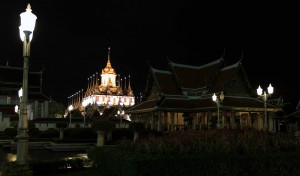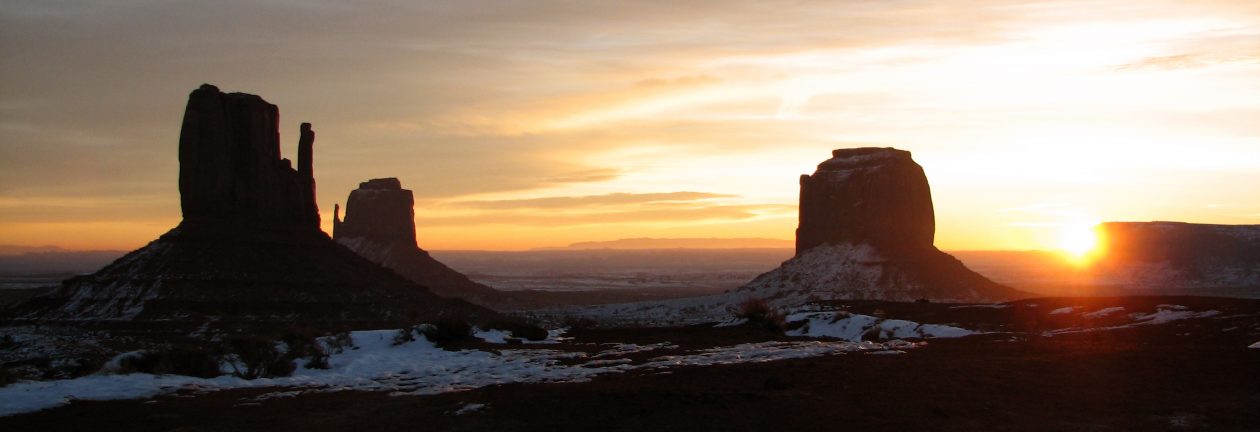Bangkok, Thailand
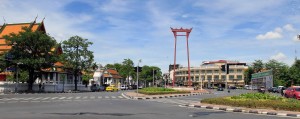
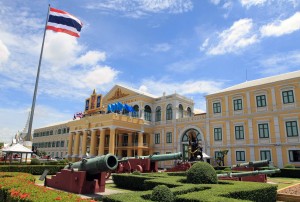
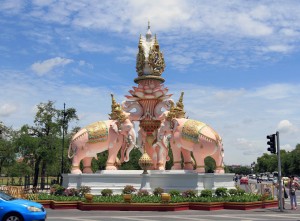
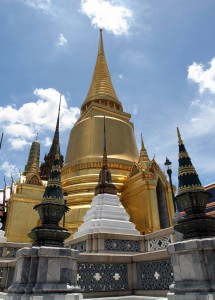
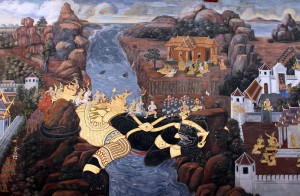
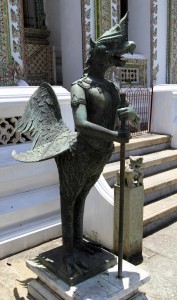
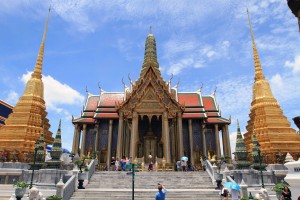
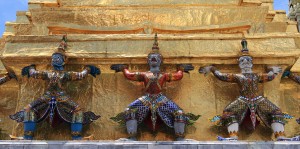
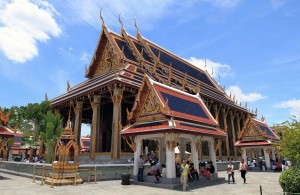
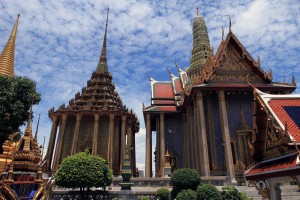
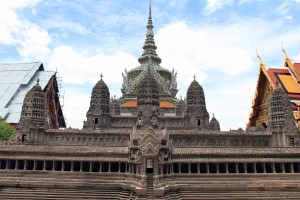
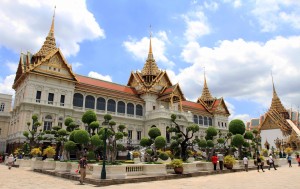
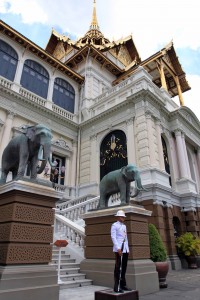
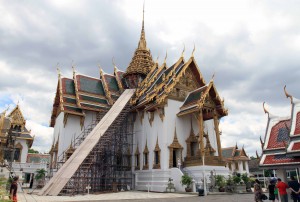
I got up today and walked west toward the Grand Palace in Bangkok. As I passed by the Ministry of Defense building a tuk-tuk driver told me the palace was closed for lunch (pointing to a closed door on the palace wall), but there was a temple nearby he could take me to in the meantime; I told him I wasn’t interested and continued walking. Lo and behold, the Grand Palace was in fact open, the actual entrance to the palace was on the north-center portion of the wall – once again, experience has proven that taxi/tuk-tuk/minivan/bus drivers lie, cheat, and scam all the time to make whatever money they can; once again, I am extremely grateful for progress such as the internet, maps and GPS, public transportation, and apps like Uber, which give everyday people the information and tools to avoid these criminals and put them out of business. So I entered the Grand Palace which was established in 1782 AD and consists of the royal residence, throne halls, government offices, and the Temple of the Emerald Buddha; the original palace was in Thonburi on the west side of the Chao Phraya River, but in 1782 King Rama I moved it to its present location and construction began in that year – over time many additions were added. I paid the entrance fee (500 baht) for the palace and walked in to the first section: the Royal Monastery of the Emerald Buddha. Surrounding the monastery is a detailed mural painted on the perimeter walls which depict events from Buddha’s life, Buddhist cosmology, Thai proverbs, and Jataka stories; the monastery has several structures with the most prominent ones being the Royal Pantheon, Phra Mondop, Phra Siratana Chedi, Hor Phra Monthian Dharma, and the Temple of the Emerald Buddha. The Emerald Buddha is actually carved from a block of green jade and was discovered in 1434 AD in a stupa in Chiang Rai; originally the jade was covered with plaster, but the abbot who had found the sculpture noticed that some plaster on the nose had scrapped off revealing the green stone underneath; the abbot assumed the green jade was emerald, thus the name. The Emerald Buddha was initially moved to Lampang, but in 1552 AD, the sculpture was then moved to Laos by King Chaichettha and it remained there until 1778 AD, when a Thai army invaded and brought the Emerald Buddha back with them. Also, the Emerald Buddha has three seasonal costumes for summer, the rainy season, and winter – he is currently wearing the rainy season costume. After walking around the royal monastery and visiting the Emerald Buddha, I exited the monastery and walked to Chakri Maha Prasat Hall. Most of the hall was closed to visitors, but two rooms with entrances on the outside housed many weapons used throughout Thailand’s history (swords, daggers, rifles, guns, canons, etc.). I then walked to Dusit Maha Prasat Throne Hall, which was built by King Rama I and is used for the lying-in-state for kings, queens, and honored members, as well as for the annual Coronation Day ceremony. I then visited a museum for the Royal Monastery of the Emerald Buddha which had many of the original adornments on the outside of the temple, as well as an old throne from the pre-Ayutthaya period and many other historic artifacts. Next, I walked to the Pavilion of Regalia, Royal Decorations, and Coins, which had many regal riches on display (i.e. gold rings with jewels, expensive necklaces, medals, many historic coins, etc.).
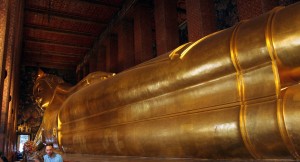
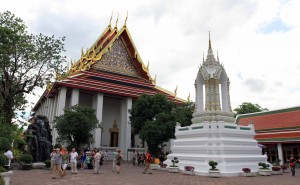
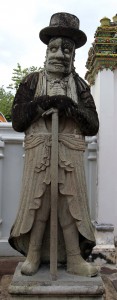
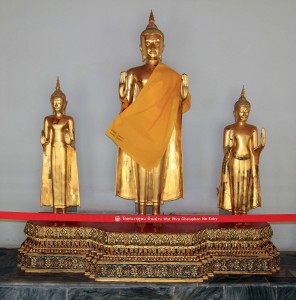
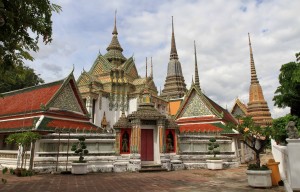
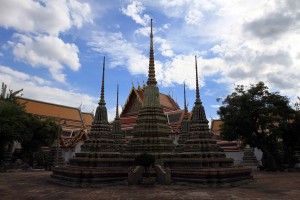
After visiting the Grand Palace, I walked south to Wat Pho (founded in 1781 AD) – the monastery’s official name is Wat Phra Chettuphon Wimon Mangkhlaram Ratchaworamahawihan and is famous for two things: being the birthplace of traditional Thai massage (there is a Thai massage school in the temple complex which offers massages) and a giant (43 meters long, 15 meters high) statue of a reclining Buddha. I first visited the Phra Buddhasaiyas building which houses the giant reclining Buddha (the largest reclining Buddha to be found in Thailand); inside the building there were also 108 bronze bowls along the wall that worshipers drop coins in to for good fortune. I then walked to Phra Maha Chedi Si Rajakam, which are a group of four large pagodas; after that, I visited Phra Buddha Deva Patimakorn – the main chapel, constructed in Ayutthaya-style, which houses a seated Buddha on a three-tier pedestal. Also, inside the temple complex near the Thai massage school, there were a number of sculptures depicting a Thai massage and traditional medicine; I did not get a Thai massage here, opting instead to receive one the next day someplace else.
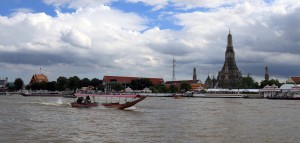
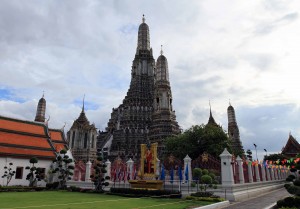
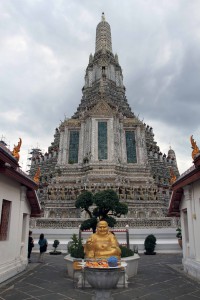
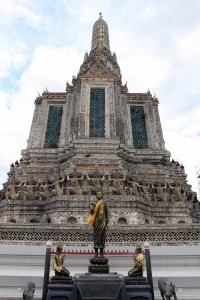
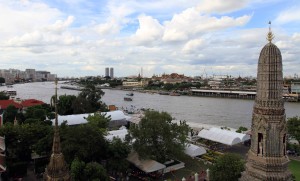
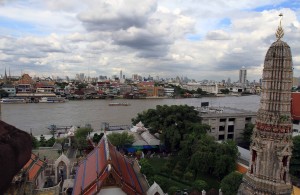
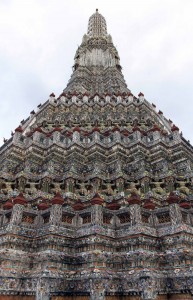
I then exited Wat Pho and walked west to the Chao Phraya River; from there I took a ferry across the water and then walked to the nearby Wat Arun (full name: Wat Arun Ratchawararam Ratchawaramahawihan; also known as “Temple of Dawn”). This Buddhist temple actually derives its name from the Hindu god Aruna and had existed since the 17th-century, however it’s current structure with one principle prang and four surrounding prang were built in the early 19th-century. The prangs are all decorated with colorful porcelain (some broken shards of pottery were put together to resemble flowers on the prangs) and there are extremely steep, narrow, and tall steps that visitors can climb to reach a top passage which offers great views of the Chao Phraya River and neighboring Bangkok. I walked up the steps of Wat Arun, took in the surrounding view, then carefully walked back down, and walked around the principle prang – unfortunately a lot of renovation work was being done on the temple, but it was mostly kept to one side of it, thus keeping it from spoiling the view from the river and main entrance.
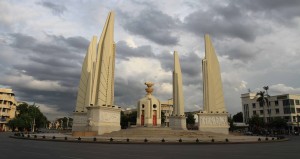
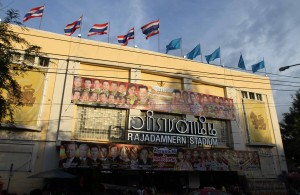
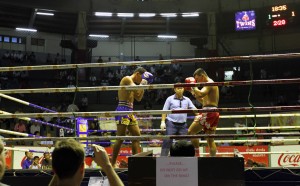
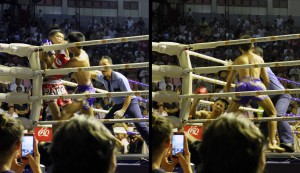
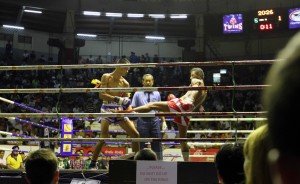
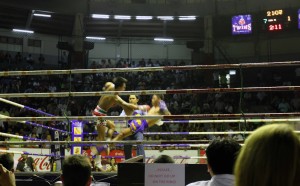
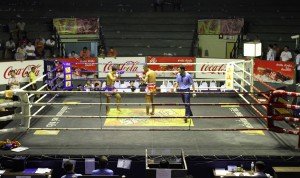
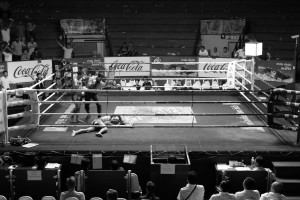
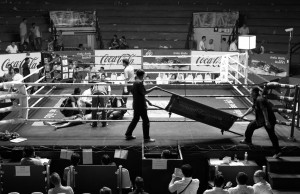
After visiting Wat Arun, I took the ferry back to the east side of the river and started walking north, toward Rajadamnern Stadium. Along the way I walked through many vendors on the sidewalk adjacent to the river and there was one monk there very interested in purchasing a dagger. I then passed by the Democracy Monument (the monument commemorates the 1932 Siamese coup d’état which led to the establishment of Thailand’s constitutional monarchy) and some canals – supposedly Bangkok is known as the “Venice of the East” (like many other cities in Asia) because of all of its canals, but I doubt Venice was ever this trashy (some canals look and smell so terrible that I fear if I fall in, I’ll never recover and die from some unidentified bacteria). I then reached Rajadamnern Stadium (built in 1941-1945) and bought ringside tickets to the Muay Thai fights scheduled for this evening (starting at 18:30). In total, there were nine fights; the best were the fourth and fifth ones; for four of the fights, they had to bring the stretcher out for a knocked out fighter, however only two were carried away on the stretcher, the other two were able to walk away with assistance. As the night went on, the cheaper, upper seats became more crowded with locals (who come to these fights to gamble – they bet using hand signals like at a stock exchange) and the cheering became louder; during the fights I had beer, a hot dog, and popcorn in lieu of a healthy, proper dinner. Surprisingly, the eighth fight proved to be more entertaining than I had expected; this fight had two grade school kids kicking the shit out of each other – it’s fun to watch two kids fight. Overall, I really enjoyed watching the Muay Thai fights and I’m glad I paid for the more expensive ringside seats. After the fight I walked back to my hotel (glad that the recent curfew had been lifted) and passed by Wat Ratcha Natdaram Worawihan, a monument to King Rama III, and Pom Mahakan (a small fort, one of many built around the old city of Bangkok). I then reached my hotel, met my three temporary room mates, and then went to sleep.
